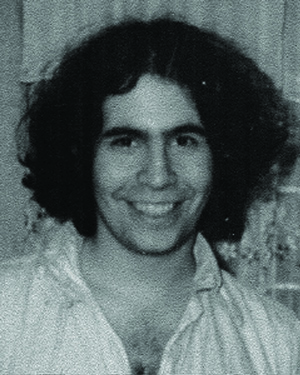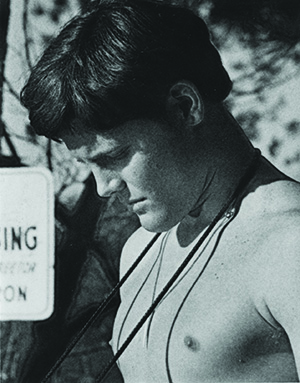The May 4 Visitors Center is only a few steps from the hill and parking lot where the tragic events of May 4, 1970 took place. Located within Taylor Hall, the center has won numerous awards for its work to preserve the memory of May 4, 1970, including a 2018 Public Education and Awareness Award from the Ohio History Connection. The center also provides services to those who have been affected by the events of May 4, including a confidential support group, yoga and meditation.
As part of the 50th commemoration, the May 4 Visitors Center presented a series of four temporary exhibitions honoring each of the students killed on May 4, 1970‚ÄĒAllison Krause, Jeffrey Miller, Sandra Scheuer and William Schroeder. The idea for the exhibitions came about after a student taking the May 4, 1970 and Its Aftermath course conducted a survey of fellow students on the Kent Campus. Fewer than one-fourth of those surveyed knew the names of the four students killed on May 4.
The May 4 Visitors Center staff took that as a call to action. Mindy Farmer, PhD, director, and Lori Boes, assistant director, decided to curate a series of exhibitions, one for each of the four slain students, that would make them more relatable to students today. They each curated two exhibitions, collaborating with Glyphix Studio, a student staffed program within the School of Visual Communication Design. Glyphix designed each exhibition under the direction of Larrie King, MFA ’14, creative director and assistant professor of visual communication design.
The first exhibition in the series opened in 2018 and the final exhibition opened in 2020. Each one documented the many facets of the students’ lives, featuring photos, letters, personal mementos and other memorabilia loaned by family members and friends. To tell their stories, the center used text written by the students themselves or their loved ones. And each exhibition had at least one piece that created connections between the slain students and current students.
For Sandy‚Äôs Scrapbook it was the phone messages from the late 1960s that visitors likened to today‚Äôs text messages. For Allison the Activist it was a letter she had written in high school to a 91≤÷Ņ‚ student asking if she could still have a social life when enrolled in the Honors College. For Bill, An All-American Boy, it was the letters and poems he wrote to his mother. And for Our Brother Jeff it was his record collection as a DJ and his relationship with his older brother.
‚ÄúToo often, Sandy, Bill, Allison and Jeff are only known for their tragic deaths,‚ÄĚ Farmer says. ‚ÄúWe wanted to show that they lived interesting and full lives. And in many ways, their stories represent the divides of the era. Allison and Jeff were activists. Bill was a member of the ROTC struggling with the meaning of the Vietnam War. Sandy was an honors student trying to get to class.‚ÄĚ
Although the exhibitions dedicated to the slain students will rotate out this year, the May 4 Visitors Center will continue themed temporary exhibitions in order to give visitors a new experience every time they come. The next theme will examine memorialization, including the initial lack of memorializing that followed the shootings because of contentious views surrounding the event.

ALLISON BETH KRAUSE
April 23, 1951 - May 4, 1970
Participating in the protest | Shot in the chest | Age 19

Allison the Activist
From the time she volunteered at a mental hospital in high school to the time she helped organize a campus wide march against the Vietnam War as a freshman, it was clear that Allison Krause was an activist.
Even though her family moved every few years for her father‚Äôs job, Allison found a home in Kent. She remembered fondly the times she traveled with her mom, dad and younger sister to eat at the Robin Hood, the only ‚Äúwhite cloth‚ÄĚ restaurant in the area.
While she was a good student and wanted to attend 91≤÷Ņ‚, she was worried about how she would be perceived if she joined the Honors College (see letter excerpt on panel at right).
Allison the Activist included photos and samples of homework, as well as images and films of her marching in protests.
At her funeral, one of her high school teachers ended his eulogy by stating, ‚ÄúIn her own quiet way, she symbolized the best in young people.‚ÄĚ
Alienation is common among all people. Many problems develop when communication between people is difficult or non-existent. It is the root of all violent outbreaks, war and all general disharmony. We live in a world with many fellow human beings and to realize that each person is not entirely alone will make alienation an obsolete human characteristic.
‚ÄĒAllison Krause


JEFFREY GLENN MILLER
March 28, 1950 - May 4, 1970
Participating in the protest | Shot in the mouth | Age 20

Our Brother Jeff
Jeff Miller was a psychology major, but his passions also led him to study the environment, criminal justice and African American history. He was also passionately against the war, as his mom wrote, ‚ÄúI expected my son to be against the war.‚ÄĚ According to her, he had a great sense of humor and liked the Mets, music, math and motorcycles.
Jeff and his older brother Russ were close, especially after their parents divorced. Jeff followed Russ to Michigan State and left for 91≤÷Ņ‚ after Russ graduated. Even when they disagreed, they shared a love for music. Jeff, who was not tall, briefly ran his own radio show, ‚ÄúShort Mort,‚ÄĚ at Michigan State University.
While he only spent one semester at 91≤÷Ņ‚ before he was killed, he had made many friends, including Allison Krause and Sandy Scheuer, who were also killed during the shootings.
Our Brother Jeff included personal items loaned by his brother, Russ, along with vinyl records, photographs, Jeff’s letters, and excerpts from his mother’s recollections.
The War Without a Purpose
marches on relentlessly,
not stopping to mourn for
ts dead,
content to wait for its end.
But all the frightened parents
who still have their son
fear that
the end is not in sight.
‚ÄĒJeff Miller


WILLIAM KNOX SCHROEDER
July 20, 1950 - May 4, 1970
Walking to class | Shot in the chest | Age 19

Bill: An All-American Boy
Bill Schroeder was athletic, loyal and extremely patriotic. He was the captain of his high school basketball team, a member of the marching band and Lorain’s youngest Eagle Scout. In 1968 he left for the Colorado School of Mines on a full Reserved Officer Training Corp (ROTC) scholarship.
In the fall of 1969, he transferred to 91≤÷Ņ‚ and changed his major to psychology. As his mother wrote, ‚Äúhe decided that the presence of a trained psychologist on the military front could be as important as a soldier‚Äôs rifle or a chaplain.‚ÄĚ
A member of the Army ROTC, he received awards for academic achievement and excellence in history, and he joined the Geology Club. His future plans had included combining military service with graduate school.
Bill: An All-American Boy gave visitors an intimate look into his life, including loving letters to his mother, photos with friends, his Boy Scout sash and Eagle Scout badge.
Learning from the past is of prime consideration. Your many influences shall linger and last, To be passed on through me to the next generation.
‚ÄĒBill Schroeder


SANDRA LEE SCHEUER
August 11, 1949 - May 4, 1970
Walking to class | Shot in the neck | Age 20

Sandy’s Scrapbook
In an era before social media, Sandy Scheuer chronicled her life in the pages of her scrapbooks. Her candid photographs, personal letters and lovingly selected mementos paint a story full of friendship, family and adventure.
At 91≤÷Ņ‚, she was a speech therapy major and honors student, a member of Alpha Xi Delta sorority and active in the Jewish community. She was a beloved daughter, sister and friend.
Bruce Burkland, her high school boyfriend, wrote, ‚ÄúTo begin to describe what a beautiful person Sandy was would take forever, but there is one thing that I want people to know about her, which is that she was not a reactionary student and was not involved in the demonstrations at 91≤÷Ņ‚.
‚ÄúSandy was not the type to cause or incite such events, but rather she always spread joy, happiness and laughter in people‚Äôs hearts wherever she went. She was the ultimate in life, especially of my life.‚ÄĚ
In the last photo of her, taken on May 2‚ÄĒlater published in Time magazine‚ÄĒshe was looking at the burned-out ROTC building and holding onto a stray dog, using a ribbon as a leash. As a friend noted, ‚ÄúSandy felt sorry for any stray animal or lonesome person and had compassion for everyone.‚ÄĚ
Sandy’s Scrapbook included photos of family trips, friends and proms, concert programs, a paddle from her sorority and while-you-were out messages.
